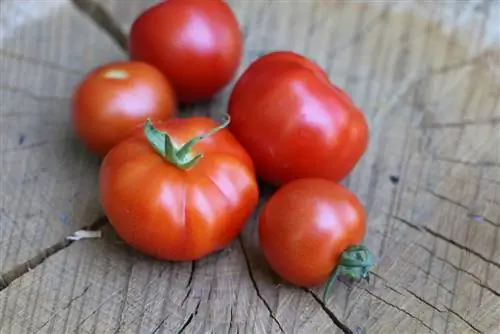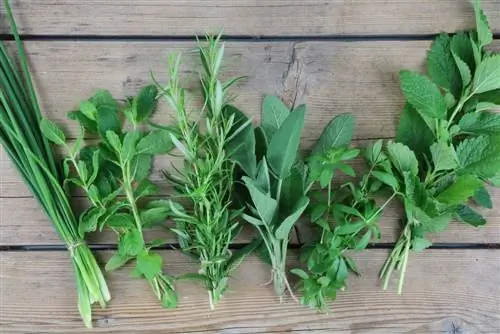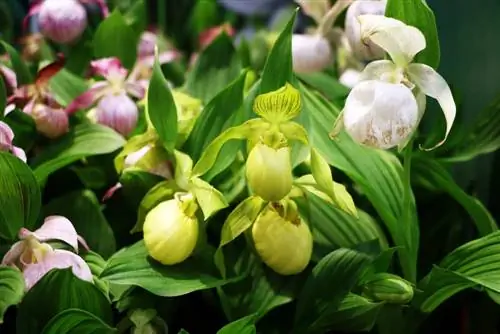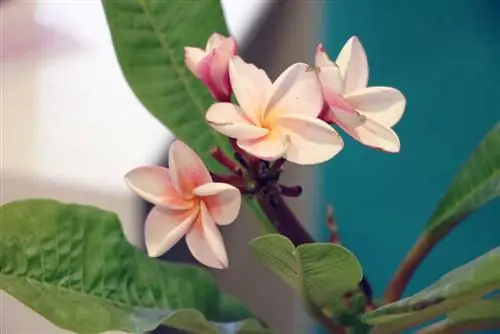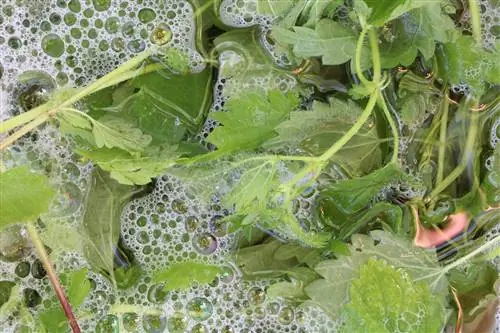- Author admin [email protected].
- Public 2023-12-17 03:39.
- Last modified 2025-01-24 12:45.
Unlike many other plants, the tomato loves a constant location, which makes it possible to plant tomatoes in the same location several years in a row without any problems. The location only needs to be changed if problems such as tomato blight occur. Due to the constant location, an adequate supply of nutrients is essential, as a lack of nutrients can lead to problems such as the fruits bursting. For the optimal supply of nutrients, not only one tomato fertilizer should be used, but also different solid and liquid fertilizers should be used over the course of the growing season. However, the tomato, as a heavy feeder, should not be in the company of other plants with high nitrogen consumption, otherwise underdevelopment can occur.
Soil preparation for tomatoes
The site is prepared for the plants in spring, for which the soil is loosened up to around one meter for the first time. This seems very deep for the first time, but tomatoes can develop roots of up to one meter, which is why a container of a suitable size should be chosen when planting on the balcony. Horse manure and horn shavings are worked into the loosened soil.
- Horn shavings are ground from the hooves and horns of cattle and have a high nitrogen content.
- In specialist shops, the horn fertilizer is available both in the form of shavings and as finely ground flour.
- The decaying process of the chips takes longer, which is why the plant is supplied with nutrients throughout the entire growing period.
The nitrogen content of horn meal is slightly lower. The advantage of very finely ground horn fertilizer is that it rots more quickly and therefore quickly supplies the tomato plants with nutrients again if there is a possible shortage.
- Horse manure in combination with horn shavings provides the tomatoes with optimal nutrients.
- The third component for soil preparation in spring is adding humus to the beds.
It offers the ideal starting aid until the roots penetrate into the deeper soil layers enriched with nutrients from horn shavings and horse manure. When preparing the soil, it is important that horn shavings and horse manure are deeply incorporated, as this also ensures that the plants root deeply and therefore have a good footing.
Fertilize tomatoes during the growth phase
During the growth phase, the young plants can be piled up with humus, which promotes growth. Later you should switch to liquid tomato fertilizer such as self-made manure or plant extracts. Fertilization and watering are only carried out in the lower area. If water or liquid tomato fertilizer often hits the leaves, the dreaded tomato rot can occur or the leaves can be burned by sunlight. The classic among self-made liquid fertilizers is nettle manure. To do this, around a kilo of nettles are placed in a bucket with ten liters of water. The manure can be used as soon as the leaves have decomposed in the water and thicker stems can be found. The decomposition process produces nitrogen and the manure is used to fertilize the plants about every two weeks.
Manure can not only be made with plants, but also with animal manure. For example, if there is still some horse manure left over from spring after soil preparation, this can also be dissolved in a bucket of water. However, when using manure, water should only be watered sparingly, otherwise over-fertilization can occur. The concentrated manure is ideally diluted with water beforehand.
Fertilize and protect tomatoes
Plant manure not only supplies the tomato plants with important nutrients, but also prevents or mitigates the infestation of diseases and pests. Field horsetail has proven itself as a natural fungicide. This can be collected yourself and prepared as manure or purchased as an extract from specialist retailers. Manure with comfrey is also good for tomato plants. They fertilize and stimulate the flowering of the perennials. It also promotes composting in the soil, which means that the nutrients from horn shavings and horse manure are available to the plants more quickly. Comfrey manure also supplies the tomato plants with important minerals such as:
- Potassium
- calcium
- Magnesium
- Copper
- Zinc
- Manganese
- Iron
- Boron
Plant manure doesn't necessarily have to be made with just one herb. A combination of several herbs is also possible. However, it is important that the manure is always diluted well so that the soil is not oversaturated with nutrients.
Tomato long-term fertilizer
The soil for the tomato plants should not only be supplied with nutrients in the short term, but long-term soil improvement should also be ensured. In addition, the nutrient balance must be balanced regularly. Horn shavings, which can also be worked into the soil in autumn, are also available. Stone powder should be applied to the bed with the tomato plants at least once a year. The stone powder supplies the plants with important minerals, which are also contained in nettle manure, for example. The tomato plants do not have to be removed from the bed in autumn and can be composted directly on site. Next year's tomato plants will appreciate the tomato fertilizer from their own plant residues. As an additional composting aid, you can water with comfrey manure in the fall. Next spring, only the plant remains that have not decomposed will be removed. By fertilizing with horn shavings in autumn, this can be avoided in spring. For a quick supply of nutrients, some horn meal can be worked into the soil in spring.
What you should know about tomato fertilizers in brief
- It's best to supply the soil with plenty of compost in autumn, because tomato plants love a humus-rich location.
- With a specific tomato fertilizer that is particularly enriched with potassium, we can best cover all the plant's needs.
- Potassium promotes growth, fruit formation and fruit ripening, promotes flavor and prevents the fruit from bursting.
- It also improves resistance to pests and leaf diseases.
- Special tomato fertilizer is of course suitable for all types of tomatoes, such as cocktail, vine or beef tomatoes - but also for cucumbers, melons, pumpkins and zucchini.
- Tomato fertilizer sticks are also practical as an alternative to liquid tomato fertilizer because they also satisfy the high need for potassium.
- Alternatively, you can of course also fertilize organic fertilizer with horse manure, cow dung and horn shavings. Stinging nettle manure is just as suitable.
Tip:
Mix one part whole milk with three parts rainwater - your tomatoes will love it!
Tomato care tips
- Tomatoes need space for the roots, this is especially important when kept in containers.
- It is best to choose varieties that are resistant to brown rot, a common disease in tomatoes.
- Don't let all the fruits ripen with large-fruited tomato varieties! Remove the youngest ones at the top of the inflorescence when they are the size of a pea or when they are already flowering!
- Never water the leaves of tomatoes!
- It is best to protect plants from rain, either by standing on the covered, protected wall of the house or in a special foil tent for tomato plants!
- De-stemming tomatoes. It is important to remove the side shoots!
- If brown rot occurs, diseased leaves must be removed immediately.
- Watering regularly ensures a good harvest. Be sure to avoid standing water!
- Watering water prevents the fruit from bursting.
- To prevent fungal diseases, the tomato plant must be in an airy position.
- Bush and stick tomatoes need a hold, a support. They are tied to a stick or with strings.
Conclusion
Tomatoes are one of the most popular foods. Growing them yourself in the garden or on the balcony is not difficult if you pay attention to a few things. There are over 10,000 varieties of tomatoes worldwide. It is important that you choose the right ones for your wishes and circumstances. Tomatoes need protection from rain and must be sufficiently watered and fertilized. Otherwise, they are not difficult to cultivate. One problem is the diseases and pests that like to attack tomato plants. It is important to discover both in good time. Then you have to take countermeasures immediately. Otherwise, keeping tomatoes is not a problem. Anyone can try it.

